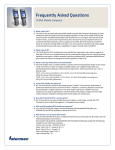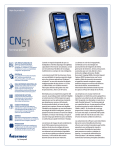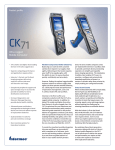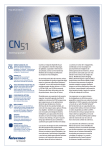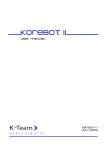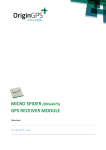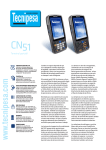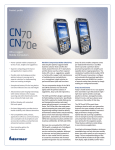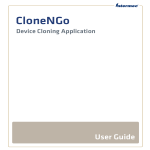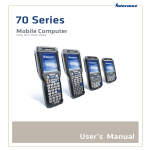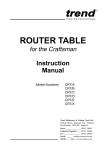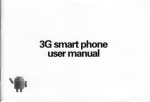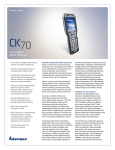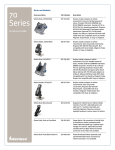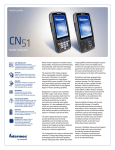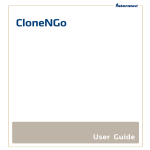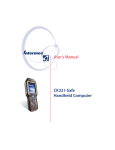Download CN51 FAQ - Honeywell Partner Concierge
Transcript
Frequently Asked Questions CN51 Mobile Computer Note: Some features described in this document are planned for future support under Android and may be not available at first release. CN51 Q: What is the CN51? A: The CN51 is Intermec’s first rugged mobile computer product to offer the choice of Windows® or Android™ operating systems on a single device. Designed for flexible application support, this next-generation mobile computing solution offers unparalleled versatility with support for Windows Embedded Handheld 6.5 and Android 4.1, and is primed for use in direct store delivery, transportation and logistics and field service operations. Q: What are the key dimensions of the CN51? A: 16.4 x 7.4 x 2.8 cm (base of unit) 3.2 cm (top of unit) (6.45 x 2.93 x 1.09-1.26 in); measurements are L x W x D. Weight with battery: 350 g (12.3 oz). Q: Is there a WiFi-only option for the CN51? A: Yes, CN51 includes a WiFi-only (WLAN-only) option. The WLAN radio is IEEE®802.11 a/b/g/n on devices without a Wireless WAN radio, and IEEE®802.11 b/g/n on cellular devices. Support for this feature under Android is planned for a future release. Q: Is there an imager/scanner option for the CN51? A: Yes, CN51 includes an integrated imager/scanner option. There are three options for imagers with the CN51: the EA30 high performance motion-tolerant 2D imager with a laser Class 2 aimer and framer, the EA31 high performance motion-tolerant 2D imager with a LED Class 1 aimer, and no imager. Support for the no-imager option under Android is planned for a future release. Q: Is there a camera option for the CN51? A: Yes, CN51 includes an integrated camera option. It is a 5 megapixel, auto focus color camera with LED flash, capable of both still photography and video capture. Q: Does the CN51 have RFID capabilities? A: No, the CN51 does not have integrated or external (such as a snap-on adapter) RFID capabilities at this time. Q: Will there be a non-incendive (NI) version of the CN51? A: No, there are no plans at this time to offer a NI version of the CN51. Environmental Q: Can CN51s be used in harsh environments? A: Yes they can. The CN51 represents Intermec’s mid-tier rugged mobile computer space. They are IP64 seal rated for rain and dust and can operate from -10C to +50C (+14F to +122F). Each CN51 configuration boasts a drop spec of 26 drops from 1.5 m (5 ft) to concrete across the operating temperature range per MIL-STD 810G, as well as withstanding 1000 tumbles at 0.5 meter per IEC 60068-2-32. Display / Touch Panel Q: What’s different about the CN51 display and touch panel? A: The CN51 has a 10.16 cm (4.0 in) transmissive WVGA (480 x 800 pixels) display. It supports 24 bpp color depth and has LED backlighting. It has an ambient light sensor that automatically adjusts the backlight to accommodate lighting variables. The CN51 is also the first product the industry to incorporate a muti-touch resistive touch panel. The resistive multi-touch technology (vs. the capacitive touch panels on most smartphones) works in real job conditions such as when it gets wet from being out in the rain, it works when the user is wearing gloves, it can capture more legible signatures with a “common” stylus/pen, and you can zoom in and out with maps and documents using your thumb and finger. Keypad Q: What keypad options are available for the CN51? A: The CN51 has two layout options, numeric and QWERTY. Numeric QWERTY Memory and Storage Q: What are the memory and storage capabilities of the CN51? A: There is 1 GB of RAM and 16 GB Flash ROM in all CN51 configurations. All configurations also have a customer accessible micro-SD slot for removable memory cards up to 32 GB in size. Microprocessor Q: What processor is used with the CN51? A: The CN51 has the Texas Instruments OMAP 4470 @ 1.5GHz. This dual core, multi-engine superscalar processor architecture has superior performance compared to XScale single core architectures at half the power consumption. Q: In determining performance, is the clock speed of this processor directly comparable to the clock speed of a single-core processor? A: Clock speed is not a comprehensive indicator of processor performance. The CN51’s dual core multi-engine TI OMAP processor is a more efficient design than single-core processors such as the Marvell PXA320. Up to twice the processing can be done on a given clock cycle, meaning the OMAP can deliver high performance at lower clock speeds, and lower clock speeds consume less power, resulting in longer battery runtimes. Single-core processors can only improve performance by increasing clock speed, producing incremental steps in performance with higher power consumption. Therefore, the clock speed of the processor alone is not sufficient to measure the overall performance of the system. Operating Systems Q: What operating systems does the CN51 use? A: The CN51 is the first product to offer both the Microsoft Windows Embedded Handheld 6.5 (WEH6.5) and Android 4.1 operating systems as options. Customers can choose either OS with the CN51 from the start. In addition, customers can choose WEH6.5 and continue to run their existing applications written for Windows Mobile or WEH6.5, add HTML5 applications for new functionality and capabilities, and then convert their CN51 to Android 4.1 at their location sometime in the future should they choose to switch to Android. Q: What configuration options for languages are available for CN51 with WEH6.5? A: The CN51 can be ordered with either Worldwide English (WWE) or Language Provisioning (LP) versions of WEH6.5. Microsoft’s LP version allows for selection of the operating system language at initial startup, and supports nine different languages (Chinese Simplified, Chinese Traditional, Worldwide English, French, German, Italian, Korean, Russian, and Spanish). Q: What configuration options for languages are available for CN51 with Android? A: None. The CN51 with Android includes built-in support for 60 languages, dialects, and localizations. The desired language may be selected via the Settings app without rebooting or resetting the device. The default language is United States English. Q: Is Microsoft’s Office Mobile suite of applications included in the CN51 with WEH6.5? A: Yes, but only with the Language Provisioning (LP) versions of WEH6.5. The Worldwide English (WWE) versions of WEH6.5 do not include the Office Mobile applications. Integrated Radios Q: What are the details on the integrated radio options in the CN51? A: All CN51 configurations include WLAN and Bluetooth radios as part of the baseline configuration. The WLAN radio is dual band 802.11n, supporting both 2.4 GHz and 5 GHz frequency bands. The WLAN is certified for WPA and WPA2 and supports CCX v4. The Bluetooth module is Power Class 1.5, Version 4 BLE. Bluetooth is a component of the WLAN module and shares the same antenna array. The WLAN/Bluetooth solution supports co-existence at both the hardware and software levels. Wireless WAN options for CN51 include: UMTS / HSPA+ (Voice & Data); Worldwide except Americas, Australia and New Zealand UMTS/HSPA Frequencies: 900, 2100 MHz Max Speeds (Network Dependent): Uplink – 5.76 Mbps Downlink – 14.4 Mbps GSM/GPRS/EDGE Frequencies: 900, 1800 MHz Max Speeds (Network Dependent): Uplink – 384 Kbps Downlink – 384 Kbps Flexible Network™ (Voice & Data); Americas, Australia and New Zealand (Can be switched between the UMTS and CDMA radio networks in North America) UMTS/HSPA+ UMTS Frequencies: 800, 850, 900, 1900, 2100 MHz GSM/GPRS/EDGE Frequencies: 850, 900, 1800, 1900 MHz Max Speeds (Network Dependent): Uplink – 5.76 Mbps Downlink – 14.4 Mbps CDMA/EV-DO Rev A Dual Band CDMA2000 Bands: BC0 & BC1 (800/1900 MHz) Max Speeds (Network Dependent): Uplink – 1.8 Mbps Downlink – 3.1 Mbps Remember that, as with all WWAN technologies, these speeds represent potential maximum speeds; actual throughput speeds are influenced by a variety of factors, many of which are beyond the control of the mobile computer. Note: The Flexible Network radio is the only WAN radio option for NA, LATAM, & ANZ, and the UMTS radio is the only WAN radio option for the rest of the world. Q: What Bluetooth stack is supported in the CN51? A: The CN51 incorporates the Bluetooth stack as it is delivered by Microsoft for WEH6.5, and by Google for Android. On occasion, Intermec may modify some stack components for enhanced functionality or improved operation. Q: What Bluetooth profiles are supported in the CN51? A: The following profiles are supported by the Windows Mobile stack on the CN51: • Generic Access Profile • Personal Area Network Profile • Human Interface Device • Serial Port Profile • Headset Profile • Hands-Free Profile •OBEX • Advanced Audio Distribution Profile (A2DP) • Dial-up Networking Profile (DUN) • Audio Video Remote Control Profile (AVRCP) The following profiles are supported by Android on CN51: • General Audio Video Distribution Profile • Device ID Profile • File Transfer Profile • Human Interface Device • Headset Profile • Hands-Free Profile • Object Push Profile - rides on top of OBEX • Advanced Audio Distribution Profile (A2DP) • Audio Video Remote Control Profile (AVRCP) • Phone Book Access Profile • Personal Area Network Profile RFCOMM is available for those looking for a “serial port” style connection. Q: Why is the Flexible Network radio not available for EMEA? A: We do not support CDMA carriers outside of North America and therefore customers would not benefit from a Flexible Network radio that allows switching between UMTS and CDMA networks. Multi-national customers desiring a common platform worldwide are a special consideration; please contact the Product Management team to discuss such opportunities. Q: Can I get cellular voice with the Flexible Network radio? A: Yes. The CN51 Flexible Network radio supports both voice and data unlike the Qualcomm Gobi 3000 radio technology which is a data only radio technology and does not support cellular voice. Note: There are also 3rd party Push-to-Talk and VoIP applications available that will allow voice communications over the data network. Q: What is the difference between UMTS in the Flexible Network radio option (available for NA, LATAM, and ANZ) and the UMTS radio option (available Worldwide except NA, LATAM, and ANZ)? A: The frequency bands supported by these configurations are slightly different: Flexible Network radio option supports UMTS 800, 850, 900, 1900, and 2100 MHz bands, and GSM/ GPRS/EDGE 850, 900, 1800, and 1900 MHz bands; UMTS radio option supports UMTS 900 and 2100 MHz bands, and GSM/ GPRS/EDGE 900 and 1800 MHz bands. Q: Where is the SIM card slot located? A: The SIM card slot is located behind a door inside the battery well. Q: How does the GPS in CN51 compare to CN50/CS40? A: The GPS receiver function in the CN51 is similar to the implementation in CN50 and CS40. It can operate in either standalone or assisted mode. Standalone mode does not require the user to have a data plan for the WWAN radio, though it does require the WWAN radio to be powered up. The assisted mode works by automatically downloading ephemeris data in the background periodically in order to maintain its table of satellite locations. This reduces the time required for the GPS to achieve its first fix. The assistance mode is optional and may be turned off to avoid data charges. Q: How is the SIM card installed? A: The SIM is held in a silver metal bracket that also houses the microSD card. To install the SIM, the top of the bracket must be moved to the left, allowing the top to rotate upward. The SIM is inserted, contacts facing down, in the top portion of the bracket, which is then rotated downward and secured by sliding to the right. Q: How does the customer switch the WWAN radio between network operators with the Flexible Network radio option? A: The Flexible Network Radio option is ideal for customers who desire to switch easily between UMTS to CDMA carriers “on the fly”. Switching network operators may be accomplished in several ways: Q: What is the purpose of a SIM card and when do I need one? A: The Subscriber Identity Module (SIM) is used by UMTS phones to provide information about the user, including phone number, contacts stored on the card, etc. SIMs are not used with CDMA phone systems. 1) Manually via the Carrier Selection application, accessed via the Windows Embedded Handheld Home screen or Android App Drawer; 2) Manually via Intermec Settings > Communications > WWAN Radio > Carrier Selection (N/A for Android); 3) Automatically using programming APIs provided by Intermec and integrated by the app developer; 4) Automatically based on signal strength or location information. (Note that these methods require the WWAN Toolkit, available for license from Intermec for WEH only.) Q: Does the GPS require the WWAN radio to operate? A: Yes, the GPS requires a WAN radio option (either the Flexible Network radio or the UMTS radio) and the WAN radio must be enabled (powered on), but a data plan with a wireless network carrier is not required to use GPS. However, assistance data used to reduce Time to First Fix (TTFF) could be sent via the WAN network with a valid data plan. Without assistance data, the GPS may experience slower TTFFs. Power/Battery Q: Does the CN51 product ship with a battery? A: Yes, all CN51 configurations ship with a removable, rechargeable Li-Ion 3.7V, 3.9 Ah battery pack. Q: Is an extended battery pack available the CN51? A: No. The standard battery pack included with CN51 is equivalent in capacity to the extended pack offered on corresponding previous products (e.g., the CN50). Q: Are the batteries for the CN51 compatible with the Intermec CN50? A: Yes, for power and charging, the CN51 battery will power the CN50 device and can be charged by the CN50. In addition, the CN50 battery will power the CN51 device and can be charged by the CN51. However, CN51 batteries include “smart battery” features that can only be realized when used with a CN51 device. The CN51 batteries include the ability to report their specific serial number, aging statistics, and impedance wear level tracking data for the purpose of proactively determining the health of a specific battery and when the mobile computer needs a new battery pack. Statistics can be accessed via the CN51 device health dashboard under WEH, the Battery Info app under Android, and/or an enterprise wide remote view with properly licensed SmartSystem consoles. Software Q: Does the CN51 have Intermec Settings? A: Yes, the CN51 with the WEH6.5 operating system includes the full suite of Intermec Settings and full support of SmartSystems™ right from the start. Android provides an extensive Settings app, which is enhanced with Intermec specific features for configuring Scanners, Ethernet, WiFi, etc. Device Management Q: What is ScanNGo and what does it do? A: Every CN51 with either WEH6.5 or Android operating system comes pre-loaded with Intermec’s unique client which provides free access to ScanNGo. ScanNGo facilitates a premium device provisioning experience for Customers by simplifying and expediting their device staging operations. It enables CN51 users to provision, configure and automatically download application software over wired, WLAN and WWAN networks significantly faster by simply reading pre-configured bar codes versus hand entry. ScanNGo eliminates the inaccuracy of hand entry, the need for skilled IT personnel on site and significant savings over other standard provisioning methods. Q: What is CloneNGo™? A: CloneNGo™ is a license-free way to easily clone devices. This Peer-to-Peer technology eliminates the need to use a management console for device provisioning. CloneNGo™ ships free on every CN51 with WEH 6.5, greatly simplifying and expediting configuration and deployment. This powerful application clones all software and setting from a fully configured ‘Master’ device to a completely un-configured ‘Client’ device via 802.11 ad-hoc wireless. The cloning process requires very minimal user intervention. A CloneNGo Master can clone its OS, file system, registry and settings (including wireless security) to other compatible devices. Note, by default the Master only transfers its settings to other devices. An SD card with specific content is required for an advanced cloning session. The ad-hoc wireless network used to transfer the data between a Master and client devices is automatically configured by the devices themselves. Because ad-hoc networking is used, this process can be completed anywhere (i.e. no network infrastructure is required to transfer data) When cloning is complete, the Master will reboot and return to its normal network configuration. The clients will apply the settings received from the Master and reboot to complete the configuration process. To launch the application, a user can navigate to the icon on the System window on the device, or scan the bar code displayed on a designated master unit. CloneNGo is currently available for WEH 6.5 only. Q: How does CloneNGo™ differ from ScanNGo™? A: ScanNGo allows communication settings to be applied to a device by scanning a barcode that’s been created via SmartSystems Console. It can cause the device to execute a wide range of management actions with a host computer or a device management console upon network connection, including distribution of activated software licenses. The devices can be located in remote locations. CloneNGo requires the master and the device under configuration to be present in the same vicinity. In addition, software licenses cannot be copied via CloneNGo. Device Heath Monitoring Q: What is device health monitoring? A: The CN51’s device health functionality provides mobile workers and IT administrators the capability to monitor and prevent issues before they impact operations. Key sub-systems like scanning, communications and wireless coverage, battery and device settings can be monitored by the mobile worker through an on-board dashboard utility or remotely through any Console including SmartSystems™ console (version 4.x or later) resulting in better utilization of your mobile computing assets. Administrators can set rules to customize how and when device health alerts are reported, and help to avoid “No Trouble Found (NTF) events”. Application Development Q: What software tools are provided with the CN51 with WEH6.5? A: To help you develop rich and easy to use line of business applications, Intermec provides, free of charge, the Intermec Developers Library (IDL). The IDL, common to all current Intermec computers, is a set of resource kits that include common code libraries and developer interfaces to Intermec value added peripherals and useful controls such as signature capture, printing, and data collection. We offer backward compatibility to applications developed using Intermec’s Developer Library resource kits. From older Intermec devices like the 700 Series to today’s CN51, your app will run as-is without any modification and minimal testing. And if you want to take advantage of some of the new hardware capabilities, like the new high-resolution camera, or GPS, the latest versions of our toolkits provide that ability while preserving the existing syntax in your source code. In addition to our rich developer libraries, our Developer Forum and online Knowledge Base provide additional developer resources such as FAQs, programming tips and technical articles. Download the IDL Resource Kits now through the Intermec Developer Center and check out what other creative developers are coming up with on our Developer Forum. Q: What demos are available for CN51s with WEH6.5? A: The Features Demo application for WEH6.5 is a collection of applets used to demonstrate various device functions including scanning, document imaging, photography, image capture, printing, GPS functionality, location services and other applications on supported Intermec WEH6.5 devices. This installation provides documentation, CAB file, and a SmartSystems software package. You can download Features Demo from the Intermec web site at: http://www.intermec.com/ Select Products > Computers > HandheldComputers > Your mobile computer > Downloads tab. Q: Is Intermec Browser available as a stand-alone application for the CN51 with WEH6.5? A: Yes. Intermec Browser, formerly known as iBrowse, is an integral part of the data collection system for customers running new web-based WMS applications. Intermec Browser is the only locked-down web client designed to work exclusively with Intermec mobile and fixed mount computers, including all CN51 configurations. Standalone Intermec Browser licenses are available for all configurations of the CN51. Intermec Browser version 1.04 or greater is required for use with the CN51 mobile computers. Q: What demos are available for CN51s with Android? A: The Features Demo application for Android provides applets used to demonstrate scanning and printing and is preloaded on the device. In addition, many apps are available for free on various Android marketplaces that can demonstrate other features of the device. Q: Is Intermec Browser available for the CN51 with Android? A: Not at this time. A Data Collection Web API is being developed to enable Intermec-specific extensions to the standard Android browser; it will be available in the near future. Apps & Components Q: Is the Intermec Client Pack (ICP) available as a factory loaded configuration on the CN51 with WEH6.5? A: The Intermec Client Pack provides both a data collection terminal emulator (Intermec Terminal Emulator) and a data collection and lockdown browser (Intermec Browser). ICP is not available as a factory loaded option on the CN51. Q: Are standalone licenses for ICP available for the CN51 with WEH6.5? A: Yes, standalone ICP (Intermec Client Pack) licenses are available for all WEH6.5 configurations of the CN51. ICP component software (ITE and Intermec Browser) can be downloaded from the Intermec public web. ITE version 1.26 or greater and Intermec Browser version 1.04 or greater are required for use with the CN51. Downloaded software will run with full functionality for 60 days before requiring a license. Buying and deploying a license will allow the downloaded software to run as a licensed product. Standalone licensing includes one year of software Maintenance. This allows a customer of standalone licensing to upgrade their ICP software for the first year after purchasing the license. Software maintenance can be extended by purchasing additional ICP Maintenance licenses. Q: Do the ICP licenses for the CN51 with WEH6.5 work the same as ICP licenses for CN50 and other Intermec mobile computers? A: Yes. There has been no change to the way ICP licenses work. Factory installed licenses are valid for the version of ITE and Intermec Browser that are installed on the device. There is no maintenance or upgrade capability built into factory installed licenses. To upgrade to a version of ITE or Intermec Browser that is released after the computer was built requires that a separate ICP maintenance license be added. Standalone ICP licenses are valid for all versions of ITE and Intermec Browser that are released prior to 1 year after the license is purchased. To extend the upgrade capability beyond one year requires that separate ICP maintenance licenses be purchased. Q: Is ICP available for the CN51 with Android? A: No. There are no current plans to develop ICP for Android. Terminal emulation clients for Android are available from multiple ISVs and third parties, including Wavelink and Stay-Linked. Q: Will the CN51 with WEH6.5 support HTML5? A: Yes. Intermec Browser V2.00 and later includes the option to run on an HTML5 compatible rendering engine. Intermec Browser provides a locked-down web client interface as well as direct access to data collection hardware such as scanners, imagers, RFID readers and mag strip readers. With the addition of the HTML5 rendering engine, Intermec Browser is also compatible with modern web technologies such as canvas, off-line storage and application caching. Intermec Browser can be licensed separately by purchasing Intermec software license 454-026-001. In addition, Intermec’s HTML5 web browser is fully supported to run on the CN51 with WEH6.5. Note that the standard Android browser in already HTML5 compatible. Q: Is Intermec Launcher available as a stand-alone application for CN51s with WEH6.5? A: Yes. Intermec Launcher (formerly iLaunch) is a configurable locked-down menu program that prevents end-users from accessing the start menu and other non-authorized applications. End-users log in and they are only able to access authorized programs. The operating system environment is only accessible with a password. This functionality allows for more control over the program flow and prevents end-user distraction, keeping them on task. The latest version of Intermec Launcher is available for download from the intermec.com website. Intermec Launcher version 2.00 or greater is required for use with the CN51 computers. Standalone Intermec Launcher licenses are available for purchase and include the first year of software maintenance. Intermec Launcher Maintenance is available to extend access to new software downloads beyond the first year. Q: Is Intermec Launcher available for CN51s under Android? A: Not at this time. Plans are underway to develop a kiosk/ lockdown mode for Android devices for release at a later date. Many third-party program launchers are available for Android. In addition, mobile device management clients such as SOTI provide whitelist/blacklist support, enabling IT to control which apps the device user is able to execute. Q: How is MDI support different for the CN51 (vs. the CN50 and CN4)? A: Intermec Mobile Document Imaging (MDI) utilizes Intermec’s advanced imaging technology to provide a fast and reliable way for mobile workers to convert full size (8.5” x 11” or A4) paper documents into electronic files while out on the road. MDI can be used in place of flatbed scanners or imaging services to reduce document management costs, streamline back office operations, and improve cash flow and responsiveness to customer requests. Unlike the CN50 and CN4 that utilize the unit’s imager for image capture, the CN51 utilizes the its high resolution auto-focus camera to capture and deliver images with 200 dpi resolution, while retaining the state of the art image correction techniques to ensure perfect image quality under challenging working environments. CN50, CN3/e, and CN4/e. Customers using the current CN50 with EA11 will find the aiming of the EA31 similar with improved scanning performance. Refer to the User’s Manual for depth of field performances. EA30 Aiming Q: Is VERDEX compatible with the CN51 under WEH 6.5? A: Yes. VERDEX is a software solution, exclusively available on Intermec mobile computers, that fully integrates all of the technologies necessary to enable fast and accurate data verification capabilities to a mobile application. VERDEX can be extremely valuable to courier and parcel delivery organizations that want to reduce the volume and associated costs of undeliverable items by correcting parcel label addresses errors before they enter their system or arrive at the sortation hub. VERDEX is supported by the CN51 as a separately licensed and field installed application. Q: Is it possible to have a scanner and camera integrated in the same device? A: Yes. The CN51’s design provides the capability to include a scanner and camera on the same device. Q: Are MDI and VERDEX available for the CN51 under Android? A: Not at this time. These apps are being considered for development under Android, though no timeline has been set. Customer requirements for this functionality should be communicated to the Software Marketing team. Scanning Q: What are the scanning capabilities and options for the CN51 configurations? A: There are three options for imagers with the CN51: the EA30 2D imager, the EA31 2D imager, and no imager. The EA30 is a high performance 2D imager with brilliant white illumination and a laser aimer with unprecedented motion tolerance. It is available on all four 70 Series models. EA30 is the industry’s fastest imaging engine, capable of scanning barcodes moving at up to 12.7 m (500 in) per second, enabling CN51s to provide remarkable “snapiness” and fast read rates even in highly dynamic environments. EA30 is capable of scanning 1D and 2D barcodes as small as 5 mil, PDF as small as 6.6 mil, Data Matrix as small as 7.5 mil, and standard UPCs at distances up to 304cm (13in). In addition to the EA30, CN51 also has the option for the EA31 high performance 2D imager. Based on the same scan engine as the EA30, EA31 high performance motion-tolerant 2D Imager is capable of scanning up to 400 in/s with the same white LED illumination and is capable of scanning all common 1D and 2D bar codes; 1D as small as 4 mils; 2D as small as 6.6 mils. The EA31 has a CCD aimer, similar to the aimer in the EA31 Aiming Q: What is Vesta decodes? A: Both the EA30 and EA31 support Vesta by default. Vesta is an Intermec patented algorithm that allows 1D barcodes to be read at further distances (EAN/UPC, Code 39 and Code 128). Furthermore, Intermec Vesta supports barcodes of higher density. See the CN51 User’s manual appendix for all scan engine depth of field performance charts. Accessories A very important element of the CN51 product line is that the majority of the current CN50 accessories are compatible. The biggest benefit to existing customers is that their investments in the accessories for the CN50 deployments are compatible with the CN51 saving considerable budget. Consult the CN51/CN50 Accessories Guide for a complete list of accessories and their compatibility. Q: What printers are supported by the CN51? A: CN51s will support the following Intermec printers: Bluetooth: PB51, PB50, PB42, PB32, PB31, PB22, PB21, PB20, PK80, 6820, PB40, PW40, PB2, and PB3 Serial: PB51, PB50, PB42, PB32, PB31, PB22, PB21, PB20, PB2, PB3 802.11: PB50 The primary method of communicating with the above printers shall be Bluetooth. Where Applicable WLAN, and USB/Serial communications shall also be supported. The Android Printing SDK provides support for PR2, PR3, PB21, PB31, PB42 and PB51 printers via Bluetooth, including text and simple graphics, e.g., barcodes. Additional functionality planned for the next release. Q: What data collection scanners is the CN51 compatible with? A: CN51s will support the following Intermec external scanners: Tethered: SR30, SR60, SR61T Wireless: SF51, SR61 Tethered scanners shall be powered and supported via the RS232 Serial Snap-on Adapter with the exception of the SR61TXR which is supported via the Powered Vehicle Dock solution. Support for tethered scanners is not available under Android at first release, but is being planned for a future release. Q: Is there a workboard printer option for the CN51? A: No, there is not a workboard printer option for the CN51. Q: What is the difference between the Vehicle Dock and Vehicle Holder? A: The Vehicle Dock provides charging to the mobile computer and data connectivity options. The Vehicle Holder uses the same mechanical package as the dock, but provides neither power nor data connectivity. Q: What power options are available for the Vehicle Dock? A: The HandEra Vehicle Dock uses the same power connector as Vehicle Docks for CN50, CN3, CK3, CK61 and 700 Series. Most of the same power kits used with those products may also be used for the CN51. In addition, a new cable designed for direct connection to 12-30V DC power ports found in some newer vehicles, or the vehicle fuse block, is available. Q: What connectivity options does the HandEra Vehicle Dock provide? A: The HandEra Vehicle Dock supports USB Host and RS232 connectivity. The RS232 port also provides +5V DC power on Pin 9 for operating handheld scanners and similar devices. North America 6001 36th Avenue West Everett, Washington 98203 Phone: (425) 348 2600 Fax: (425) 355 9551 North Latin America Mexico Phone: (+52) 55 52 41 48 00 Toll Free NOLA: 01800 490 4990 Q: What mounting options are available for Vehicle Docks and Holders? A: The RAM mount specified in the Price Guide must be used with the Vehicle Dock or Vehicle Holder to preserve the integrity of the dock during all possible usage scenarios. Intermec does not support the use of other mounting systems. Q: Which accessories are compatible with Vehicle Docks and Holders? A: Snap-on adapters (including MSR, RS232, and USB) and Scan Handle are not compatible with the Vehicle Dock/Holder. Q: Can the Vehicle Dock or Holder be used in a forklift application? A: Yes, the Vehicle Dock/Holders are approved for use in forklift environments. Use of the RAM mount specified in the Price Guide is required. Q: Must the snap-on adapters (including MSR, RS232, and USB) be removed to dock or charge the CN51? A: Yes, all snap-on adapter oprions must be removed in order to dock or charge the CN51. South Latin America Brazil Phone: (+55) 11 3711 6770 Fax: (+55) 11 5502 6780 Media Sales EMEA: (+31) 24 372 3167 USA: (513) 874 5882 http://intermec.custhelp.com Customer Service & Support Toll Free NA: (800) 755 5505 Toll in NA: (425) 356 1799 EMEA: intermec.custhelp.com Europe, Middle East & Africa Reading, United Kingdom Phone: (+44) 118 923 0800 Fax: (+44) 118 923 0801 Sales Toll Free NA: (800) 934 3163 Toll in NA: (425) 348 2726 Freephone ROW: 00800 4488 8844 Internet www.intermec.com Asia Pacific Singapore Phone: (+65) 6303 2100 Fax: (+65) 6303 2199 Worldwide Locations www.intermec.com/locations OEM Sales Phone: (425) 348 2762 © 2013 Honeywell International Inc. 612308-A 09/13







